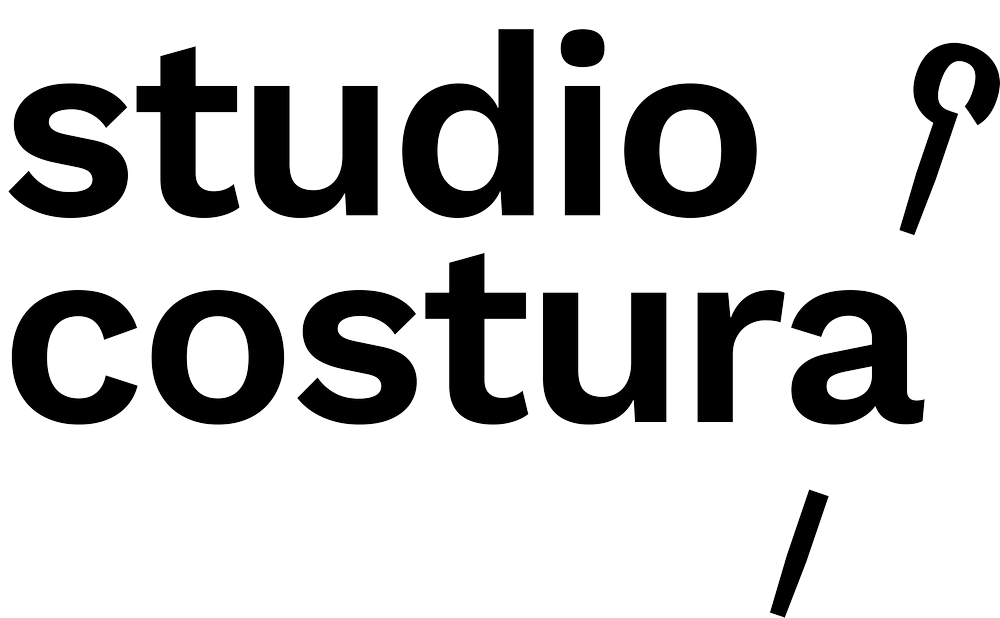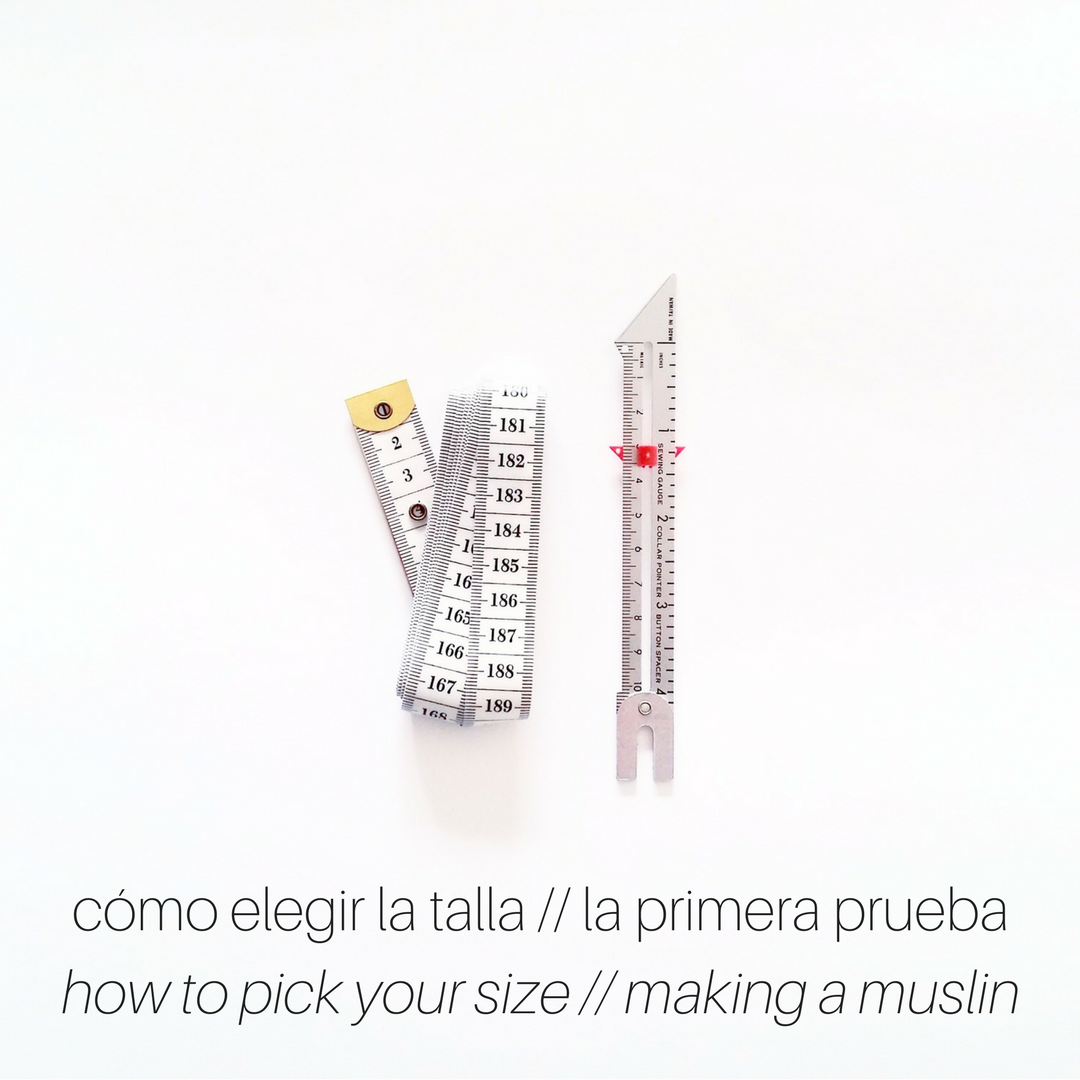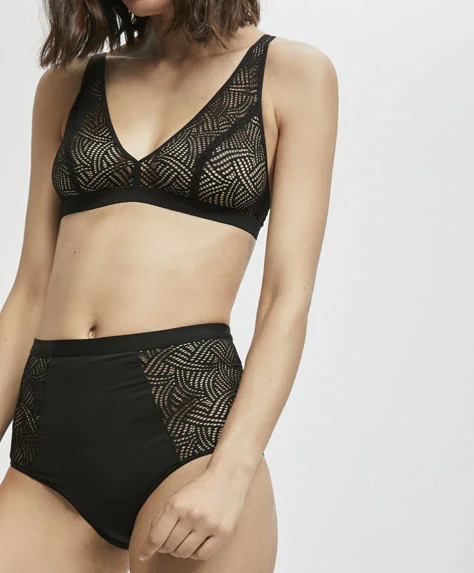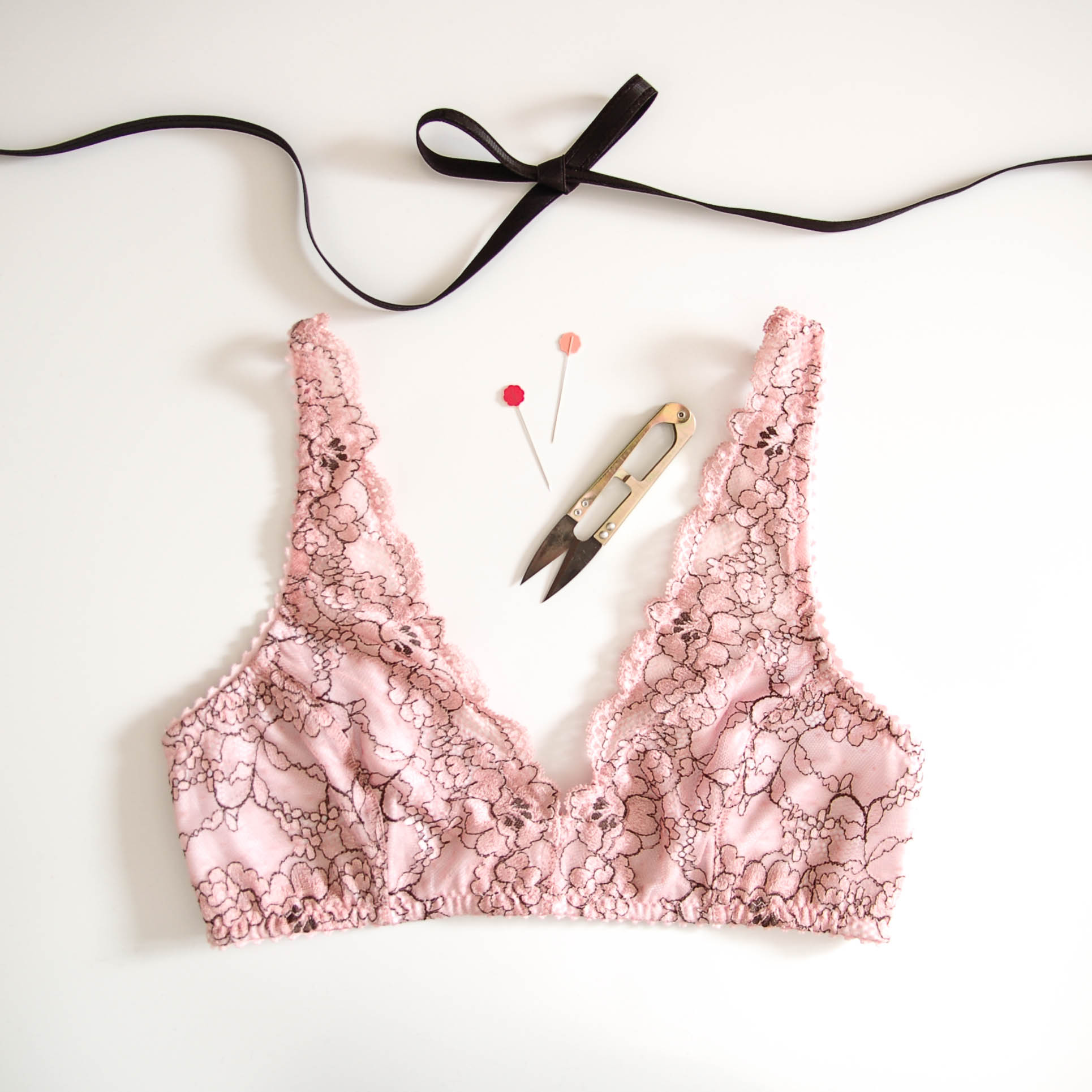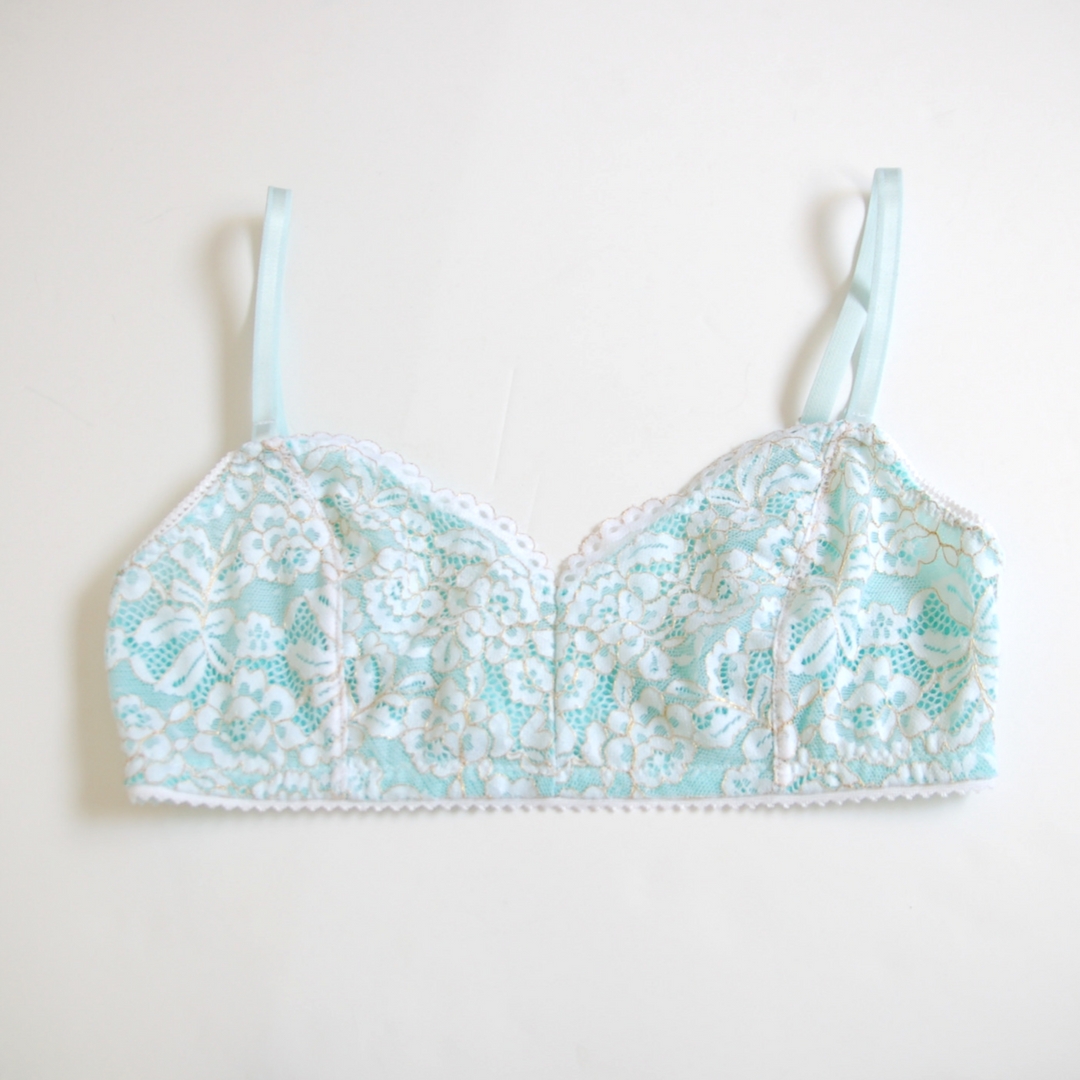Hola! Hoy vamos a cortar las piezas para el bralette Hanna. Después de hacer la prueba en el anterior post ya podemos empezar con el encaje. Voy a contaros cómo cortar el encaje de la manera que las piezas salgan simétricas y que el escote quede bonito. He escrito ya antes sobre este tema si quieres mirar este post para más información.
Hey! Today we are going to cut the pattern pieces for the Hanna bralette. After making a quick muslin in the last post we can now cut into the lace. I'll tell you how to cut the pices from lace in a way that they'll be symmetrical and the neckline will be very pretty. I actually have written about this topic before, you can read this post for more information.
Antes de corte quería también que reviséis si el cierre cuadra bien con la pieza de la banda. Cómo os comenté antes, los cierres vienen en diferentes anchos y es mejor comprobar antes si todo cuadra. El ancho de final de la banda debería medir lo mismo que tu cierre + dos veces el el elástico que vas a utilizar. Para comprobarlo coloca el cierre en el medio y mide si en los bordes de abajo y arriba cabe justo la medida de tu elástico (los elásticos se doblan hacia el revés una vez cosidos).
Before cutting I'd like you to revise if your closure fits properly with the band piece. As I told you before the closures come in a variety of widths and it's better to see if yours fits well before cutting out the band pieces. The width in the end of your band piece should measure the same as your closure + two times the width of your elastic. To see if that's your case you need to put the closure in the middle and see if the elastics fit exactly in the upper part and the band part (the elastics will be folded down and they will be on the reverse side of te bralette after sewing).
En el caso de que tu cierre sea más ancho o que directamente quieres usar un cierre de tres filas en vez de dos hay que hacer un fácil ajuste al patrón. Mide el ancho de tu cierre y sumale dos veces el ancho de tu elástico. Copia tu patrón de la banda en una hoja de papel y allí mide el ancho que necesitas (el cierre + dos veces el elástico). Luego une ese punto con el otro lado donde la banda luego se une a la copa. En la foto he hecho una línea discontinua que marca mi nuevo patrón para que vaya bien para el cierre de tres filas. Si tu caso es contrario y tu cierre mide menos, lo que tienes que hacer es disminuir el patrón de la misma manera.
In case your closure is wider or if you want to use a three-row closure instead of a two-row one you need to make a simple adjustment on the pattern piece. Copy your pattern piece onto a blank paper and measure there the new width you need (the closure + two times the elastic). Now trace the new seam line to the other side where the band piece will eventually be sewn together with the outer cup piece. In the photo I have made a spotted line to mark my new pattern piece so I can use a three-row closure. If you are using a smaller closure you need to make the same type of adjustment.
Ahora ya vamos a cortar el encaje. Coloca el encaje en una sola capa con el derecho hacia arriba. Coloca el patrón de pieza A encima del encaje de la manera que la línea recta y larga (el escote) se queda alineada con la parte más baja de la puntilla. Aquí la idea es que independientemente de la diferencia de que tenga tu puntilla en la parte más alta y baja, tú no vas a modificar el ancho de la copa. Por eso es importante poner el patrón en la parte baja de la puntilla, donde comienza digamos. El piquete en esa línea tienes que colocarlo en el punto donde empieza una parte de la puntilla. Ese piquete te marca donde luego está la costura central del bralette y de esa manera la puntilla va a empezar justo en este punto y crea un efecto bonito de simetría.
Now it's time to cut the lace. Put the lace on a single layer with the right side facing up on your cutting table. Put the pattern piece A onto the lace in a way that the longest straight line of the piece (the neckline) matches with the scalloped edge of the lace in the part where the scallops start (on the lowest part of the scallops). The idea here is to not reduce the cup piece and that's why it doesn't matter if the scallops on your lace are wider or narrower, you still put the pattern piece aligned with the lowest part. The notch on this pattern needs to be aligned with a point where one scallop starts. This notch indicates where the central seam of the bralette will be and that way you'll have beautiful scallops starting exactly at that point on the neckline of your bralette.
El encaje se puede cortar perfectamente con las tijeras pero la verdad es que el cutter es bastante cómodo y deja las líneas de corte muy precisas. Ahora ya tienes una copa interior cortada. Para poder tener la simetría de dibujo en tu encaje y que las dos copas sean exactamente iguales te recomiendo cortar la otra pieza con la ayuda de la primera que has cortado en vez de usar el patrón en papel.
You can perfectly cut the lace with your normal cutting scissors but to be honest the rotary cutter is very comfortable and leaves very neat edges. Now you have one of the inner cups cut out. To make the pieces symmetrical I recommend you to cut the second piece of your inner cup with the help of the first one insteaad of using the paper pattern.
La idea es que le das la vuelta a tu pieza A de encaje que acabas de cortar para que las piezas ahora se queden el derecho con derecho y busques justo el lugar donde coincide el dibujo. Dependiendo de cada encaje el dibujo se repite cada tanto y a veces puedes aprovechar el material más a veces menos. En general te va a cuadrar la pieza justo si lo cortas en la otra orilla del encaje. Cómo ves yo corté la primera pieza arriba y ahora lo he colocado abajo, me van a coincidir las piezas exactamente. Ahora corta esa pieza siguiendo el contorno del primero.
The idea here is to turn your first piece A around so the right sides of the lace will be together. Find a place where the lace matches up exactly on both of the layers. Every lace is different and the pattern repeats every now and then, sometimes you can save up more lace while cutting the pieces closer together and sometimes you need more space to find the matching pattern. In general the scallops match up on the other border of the lace. As you can see I cut out my fisrt piece on the upper part of the lace and then found the matching place on the lower part of it. Now cut this piece following the lines of the first one.
De esa manera conseguimos que el encaje quede simétrico, tiene bastante buena pinta!
That way we get perfectly symmetrical pieces, looks quite good!
Las piezas B y C tienes que cortarlas del encaje también. Aquí no va a quedar el borde de la puntilla a la vista así que no tienes que preocuparte de cuadrar nada. Sigue la línea de máxima elasticidad marcada en el patrón para colocar correctamente las piezas (si eres observadora ves que mi pieza C está inclinada...ha sido el error que tenía a la hora de hacer esta foto que luego correguí, jaja). El encaje se mueve bastante pero si ves que lo manejas bien puedes cortar estas dos piezas directamente en doblez de la tela ya que necesitas dos de cada una. Sino corta dos y luego otros dos en una sola capa, que allí ya depende de vosotras.
The pattern pieces B and C need to be cut from lace too. As here we won't have a visible scalloped lace edge anywhere you don't need to worry about matching patterns. Follow the greatest stretch direction on your pattern pieces to align them accordingly (if you look well enough you can actually see that my pattern piece C is tilted on that picture...it was an error on that photo that I later fixed, hehe). Lace moves quite a bit but if you feel like you are managing it well you can cut it on double layer to directly cut out two of both of the pattern pieces you need. If not just cut two of them on a single layer and then repeat.
Aquí están todas las piezas del patrón que necesitas cortar de encaje. Esta vez sí que busqué la simetría también en las piezas B y C (cortando primero una y luego buscando su dibujo) porque este encaje en particular tiene un dibujo de rayas muy pronunciado y quería que quede bonito luego. Muchas veces eso no es tan importante porque con los flores etc no se nota casi la diferencia.
Here are all of the pattern pieces you need to cut from the lace. This time I actually did match the lace on my outer cup and band pieces too (by cutting first one and then finding its match) because this particular lace has a prominent line pattern and I wanted it to repeat well. Lots of times this is not so important as the different pieces on floral patterns etc won't be at all visible.
Ahora vamos con el forro de tela de punto. Dobla la tela para cortar directamente dos piezas de cada pieza de patrón que necesitas. Son las piezas B, C y D.
Now let's cut the knit fabric lining. Fold the fabric to be able to cut on the double layer and directly cut two of each of the pieces B, C and D.
No te olvides de marcar los piquetes cuando cortas las piezas. En las instrucciones he dicho que uses un marcador textil que se vaya con agua, nunca cortes los piquetes como lo hacemos al coser ropa porque los margenes son tan pequeños que luego se puede notar el corte. A veces tienes el encaje de la forma o de color que hace imposible marcar el piquete con el rotulador, en ese caso suelo marcar los piquetes con un alfiler. Es un poco rollo a la hora de mover las piezas y tienes que tener más cuidado pero es una solución.
Por fin tenemos todo preparado para empezar a coser! Me olvidé comentaros en el post de los materiales pero también necesitáis aguja de bola para tejidos de punto para la máquina domestica (con nombres como jersey, stretch, ballpoint etc). Espero que el corte no haya sido muy difícil! Si tenéis cualquier pregunta lo podéis poner en los comentarios.
Don't forget to mark the notches on tha pattern pieces when you cut them out. I've mentioned in the instructions that you should use a water soluble fabric marker to do so. Don't cut the notches as we many times do when sewing garments, the seam allowance is so small that this might show later on. Sometimes the lace has a form or a color that makes it hard to mark with a marker, in that case I usually mark my notches with pins. It's a bit difficult to move the pieces around with pins in them but if you are careful it can be a solution.
Finally we have everything ready to start sewing! I forgot to tell you in the supplies post that you also need a stretch needle for knit fabrics for your domestic machine (named as jersey, stretch, ballpoint). I hope that the cutting process wasn't too difficult! If you have any questions you can post them on the comments section.
